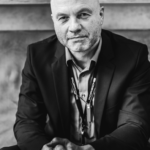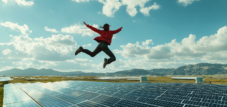Published on: April 7, 2025 / update from: April 7, 2025 - Author: Konrad Wolfenstein

Solar park and electrolysis in Boossen: An innovative hydrogen project in Frankfurt/Oder - creative image: Xpert.digital
Energy transition in Boossen: Solar energy and hydrogen production combined
Green hydrogen from solar energy: Frankfurt (Oder) sets standards
The city of Frankfurt (Oder) plans to build an integrated energy project in its Boossen district that combines a solar park with an electrolysis system for hydrogen production. This project is part of the growing number of hydrogen projects in East Germany and represents an important building block for the regional energy transition. The project not only promises the local generation of renewable energy, but also its conversion into storable green hydrogen, which can be used as a versatile energy source.
Suitable for:
- Solar energy expansion in Brandenburg: Three XL-Solarpark major projects in focus-Neuruppin, Vierlinden (Görlsdorf) to Ketzin
Hydrogen production through electrolysis: basics and technology
The production of green hydrogen is produced by a process called electrolysis, in which water is split into its components hydrogen and oxygen using electrical current. This process takes place in an electrochemical cell, whereby the electrical load causes the conversion of the water into hydrogen and oxygen. The use of electricity from renewable energy sources such as solar or wind power is crucial for classification as a “green” hydrogen.
Electrolysis technology makes it possible to store excess renewable energy and thus to counter the fluctuating electricity offer from wind and photovoltaic systems. The hydrogen generated can be stored in high -pressure tanks and later used for various applications, for example as a fuel for heavy goods traffic or for industrial processes.
Different electrolysis procedures in comparison
Various technologies are available for electrolysis. While PEM technology (Proton Exchange Membrane) has high electricity densities, it requires expensive precious metals and only achieves mediocre efficiency. An alternative approach is the use of membranes for alkaline electrolytes in combination with cheaper nickel electrodes, which can reduce production costs.
The planned hydrogen project in Boossen
The project planned in Boossen provides for the construction of a solar park to provide renewable energy for the electrolysis system. The electrolysis system will split water into hydrogen and oxygen, whereby the hydrogen can then be compressed and saved.
Integration into regional hydrogen infrastructures is a central part of the project. Boossen is mentioned in connection with the establishment of regional hydrogen nets, which indicates a integration into overarching infrastructure projects. The proximity to the Frankfurt/Rhein-Main metropolitan region, for which a separate regional distribution network for hydrogen called “Rh2ein-Main Connect” is planned, could play a role.
The city of Frankfurt (Oder) has already decided a PV action strategy that sets the framework for the development of solar parks. This strategy should also be relevant for the project in Boossen and define criteria for the choice of location and implementation.
Regional embedding: hydrogen projects in East Germany
The Boossener project is part of a broader initiative to establish a hydrogen economy in East Germany. A central element is the “electrolysis corridor East Germany”, which is developed as part of the “Doing Hydrogen” IPCEI composite project. This project networked innovative individual projects in East Germany and forms an important building block for the implementation of the German and European hydrogen strategy.
In Brandenburg and Mecklenburg-Western Pomerania, two electrolysis facilities with a total output of 185 megawatts are created, which are to produce 17,000 tons of hydrogen annually from 2028. The installed overall output of this electrolyseurs is distributed to two locations and forms a cross -border corridor.
Further hydrogen projects in the region
In Osterweddingen near Magdeburg, the company Enerbagen is building an electrolysis system with 10 megawatts of power, which is scheduled to start operating at the end of 2025. The annual production capacity of this system is 900 tons of green hydrogen, whereby the electricity is obtained exclusively from the company's onshore wind farms.
Together with VNG and Ontras in Lusatia, the EnBW plans to build a complete value chain for green hydrogen. For this purpose, wind and solar parks are to be built, produce the green electricity in the region and feed it into the public network. A regionally built electrolyser is to remove the generated green current from the network and produce hydrogen through electrolysis.
Challenges and potential of local hydrogen production
The implementation of hydrogen projects such as that in Boossen is associated with various challenges. This includes technical aspects such as the efficiency of electrolysis and the storage of hydrogen, but also economic factors such as production costs and competitiveness.
Suitable for:
Acceptance and land use
An important aspect is the local acceptance of such projects. In Brandenburg there is partly resistance to the expansion of solar parks, as the example in Sydower flows. Residents fear disadvantages such as falling real estate values or visual impairments. At the same time, municipalities hope for higher tax revenue through such projects.
The use of land is another critical point. Solar parks need significant areas, which are then no longer available for other uses such as agricultural production. Alternative locations such as former landfills or the integration of PV systems into existing structures can reduce conflicts.
Innovation potential: from the laboratory to practice
Research on smaller, more efficient electrolysis systems is progressing. At the Frankfurt University of Applied Sciences, for example, research is being carried out on a “smart tanker for hydrogen”, which is intended to simplify the production of green hydrogen in such a way that use can also succeed in private houses or small businesses. In the future, such innovations could also improve efficiency of larger systems such as the planned in Boossen.
In the second phase of this research project, an innovative compressor station for green hydrogen is now being built up as a prototype based on the previous work results together with industrial partners in the laboratory. The findings from such projects can also be relevant for larger systems such as the planned planned.
Boossen as part of the hydrogen strategy
The planned project of a solar park with an electrolysis system in Boossen (Frankfurt/Oder) blends into the broader strategy for building a hydrogen economy in East Germany. It combines the local production of renewable energy with the production of green hydrogen, which can be used as a versatile energy source for different applications.
Integration into regional and national hydrogen nets enables the transport of the hydrogen to go to consumers in industry, mobility and municipal care. The project thus contributes to achieving the climate protection goals and supports the structural change in the region.
However, the successful implementation requires the consideration of local interests and transparent communication with the residents. This is the only way to achieve the necessary acceptance for the expansion of renewable energies and the associated hydrogen production. At the same time, the project offers opportunities for local added value and can contribute to strengthening the regional economy.
Suitable for:
Your partner for business development in the field of photovoltaics and construction
From industrial roof PV to solar parks to larger solar parking spaces
☑️ Our business language is English or German
☑️ NEW: Correspondence in your national language!
I would be happy to serve you and my team as a personal advisor.
You can contact me by filling out the contact form or simply call me on +49 89 89 674 804 (Munich) . My email address is: wolfenstein ∂ xpert.digital
I'm looking forward to our joint project.













